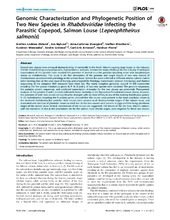| dc.contributor.author | Økland, Arnfinn Lodden | eng |
| dc.contributor.author | Nylund, Are | eng |
| dc.contributor.author | Øvergård, Aina-Cathrine | eng |
| dc.contributor.author | Blindheim, Steffen H. | eng |
| dc.contributor.author | Watanabe, Kuninori | eng |
| dc.contributor.author | Grotmol, Sindre | eng |
| dc.contributor.author | Arnesen, Carl-Erik | eng |
| dc.contributor.author | Plarre, Heidrun | eng |
| dc.date.accessioned | 2015-03-18T12:39:53Z | |
| dc.date.available | 2015-03-18T12:39:53Z | |
| dc.date.issued | 2014-11-17 | eng |
| dc.identifier.issn | 1932-6203 | en_US |
| dc.identifier.uri | http://hdl.handle.net/1956/9576 | |
| dc.description.abstract | Several new viruses have emerged during farming of salmonids in the North Atlantic causing large losses to the industry. Still the blood feeding copepod parasite, Lepeophtheirus salmonis, remains the major challenge for the industry. Histological examinations of this parasite have revealed the presence of several virus-like particles including some with morphologies similar to rhabdoviruses. This study is the first description of the genome and target tissues of two new species of rhabdoviruses associated with pathology in the salmon louse. Salmon lice were collected at different Atlantic salmon (Salmo salar) farming sites on the west coast of Norway and prepared for histology, transmission electron microscopy and Illumina sequencing of the complete RNA extracted from these lice. The nearly complete genomes, around 11 600 nucleotides encoding the five typical rhabdovirus genes N, P, M, G and L, of two new species were obtained. The genome sequences, the putative protein sequences, and predicted transcription strategies for the two viruses are presented. Phylogenetic analyses of the putative N and L proteins indicated closest similarity to the Sigmavirus/Dimarhabdoviruses cluster, however, the genomes of both new viruses are significantly diverged with no close affinity to any of the existing rhabdovirus genera. In situ hybridization, targeting the N protein genes, showed that the viruses were present in the same glandular tissues as the observed rhabdovirus-like particles. Both viruses were present in all developmental stages of the salmon louse, and associated with necrosis of glandular tissues in adult lice. As the two viruses were present in eggs and free-living planktonic stages of the salmon louse vertical, transmission of the viruses are suggested. The tissues of the lice host, Atlantic salmon, with the exception of skin at the attachment site for the salmon louse chalimi stages, were negative for these two viruses. | en_US |
| dc.language.iso | eng | eng |
| dc.publisher | Public Library of Science | en_US |
| dc.rights | Attribution CC BY | eng |
| dc.rights.uri | http://creativecommons.org/licenses/by/4.0/ | eng |
| dc.title | Genomic characterization and phylogenetic position of two new species in Rhabdoviridae infecting the parasitic copepod, salmon louse (Lepeophtheirus salmonis) | en_US |
| dc.type | Peer reviewed | |
| dc.type | Journal article | |
| dc.date.updated | 2015-03-03T14:56:06Z | en_US |
| dc.description.version | publishedVersion | en_US |
| dc.rights.holder | Copyright 2014 Økland et al. This is an open-access article distributed under the terms of the Creative Commons Attribution License, which permits unrestricted use, distribution, and reproduction in any medium, provided the original author and source are credited. | en_US |
| dc.source.articlenumber | e112517 | |
| dc.identifier.doi | https://doi.org/10.1371/journal.pone.0112517 | |
| dc.identifier.cristin | 1207896 | |
| dc.source.journal | PLoS ONE | |
| dc.source.40 | 9 | |
| dc.source.14 | 11 | |
| dc.subject.nsi | VDP::Mathematics and natural scienses: 400::Basic biosciences: 470::Genetics and genomics: 474 | en_US |
| dc.subject.nsi | VDP::Matematikk og naturvitenskap: 400::Basale biofag: 470::Genetikk og genomikk: 474 | nob |

